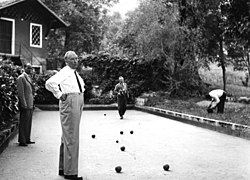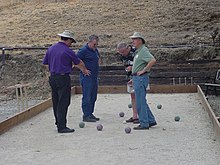Boccia
Boccia [ ˈbɔʧa ] is the Italian variant of the boule game , in which the aim is to place your own balls as close as possible to a smaller target ball (Pallino) or to shoot the opponent's balls away from the Pallino ( Raffa or Volo ). Boccia is also known as a precision sport.
Boccia has been a Paralympic sport since 1984 .
In Croatia , boccia is called boćanje or balote ( balota , Croatian for "boccia ball").
Boccia in Germany
In Germany, boccia is not as widespread as in Italy, Switzerland or Austria. But there are enough boccia players, mainly from southern Germany. There are currently eleven clubs that host tournaments. The Boccia Bund Deutschland e. V. belongs to the German Boccia, Boule and Pétanque Association . The "Boccia Bund Deutschland" currently has around 350 members, 200 of whom play actively in various leagues. The incumbent president has been Giuseppe Garieri from Augsburg since February 25, 2018. The Boccia Bund Deutschland also maintains national teams (men, women and youth) that take part in the World Cup and European Championship.
Bocce court and balls
In contrast to the leisure variant (see boules game ), boccia is not played on grass, but “on level and perfectly leveled ground, divided into regular lanes, delimited by boards made of wood or other non-metallic materials. The height is 25 cm, with a tolerance limit of +/- 2 cm. “The track is 26.50 m × 4.50 m wide. It is divided into sections (see also Boulodrome ).
The Pallino and the balls have the prescribed dimensions (see competition balls ). There are precise rules and play points for throwing the pallino and the balls, the position of the balls must be marked on the field. The balls of a team (formation) must be identical to each other and differ from those of the opponent. They have a diameter of 107 mm and a weight of 920 g; Junior and women's balls are only slightly changed (diameter 106 mm, weight 900 g).
regulate
Boccia as a sport is played in Germany according to international rules. Depending on the number of players per team (formation), they may play with a different number of balls:
- in single ( individuale ; one against one) everyone has 4 balls;
- in doubles ( coppia ; two against two) each player has 2 balls;
- in a threesome ( terna ; three against three) each player has 2 balls.
According to the international rules, a game goes up to 15 points. The German Boccia Federation can also set a limit of 12 points per game for various competitions.
Litters
There are two different litters:
- In the Raffa throw, the ball must be thrown at least over the D-line (about 7–8 m from the point of throw). The player has to announce which balls (pallino or point ball) he wants to hit.
- In the Volo throw, in which the target must also be announced, the ball may only touch a limited part of the ground and may land a maximum of 40 cm in front of the ball.
If the pallino and ball (s) are more than 13 cm together, the ball (s) and pallino may be hit with the announcement “Pallino” . The referee must announce this situation with “bersaglio” . Balls hit that do not comply with the rules are replaced and must therefore be marked. At the end of a game set (also called Kehre according to German rules , Italian giocata ) the balls that are closer to the Pallino than those of the opponent count as points; then the game is played in the opposite direction.
Individual evidence
- ^ Association list of the Boccia Federation Germany .
- ↑ http://boccia-bund-deutschland.de/archiv/ligen/nationalmannschaften/index.html
- ↑ cf. Boccia rules on the website of the Boccia Bund Germany
- ↑ http://www.eba-online.eu/Reg_Int_DEUTSCH.pdf



